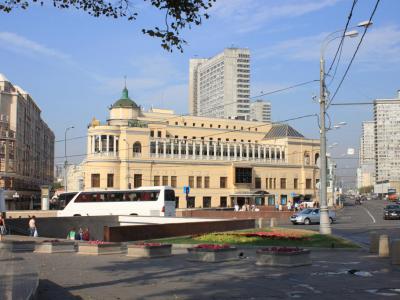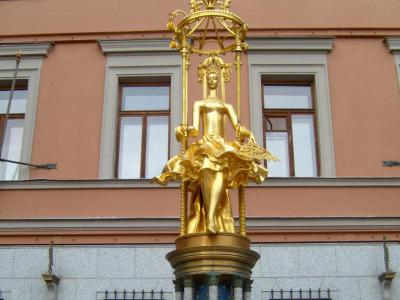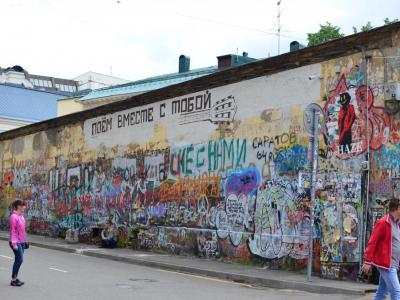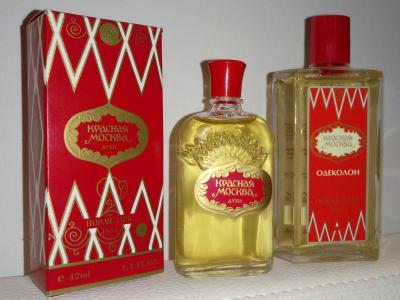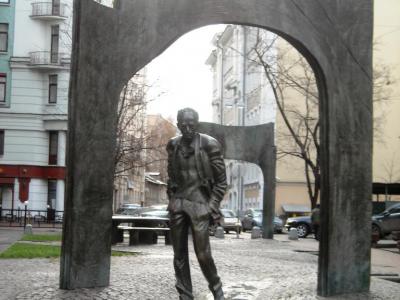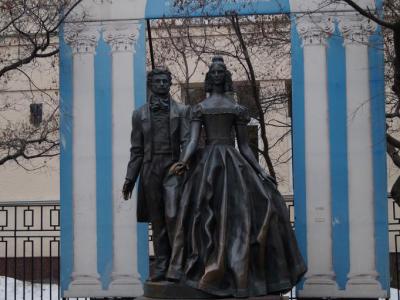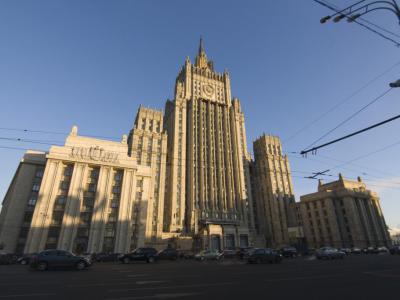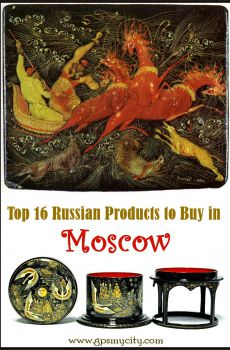Arbat Street Walking Tour (Self Guided), Moscow
The historic center of Moscow is mainly associated with Arbat, one of the oldest streets in the city, emerged as far back as the early 15th century. The origin of the name “Arbat” is subject to numerous theories suggesting the Russian, Tatar, Persian, or even Arab roots, meaning the "bumpy road", the "cart road", the "suburb", or the "outskirts".
The gateway to Arbat Street, Arbatskaya Square is a bustling hub where you can soak in the lively atmosphere and start your exploration. Venturing further, you will come across the Entertainment Center, offering a range of fun options to have a good time.
The Princess Turandot Fountain-Monument, an elegant tribute to the classic opera character, marks the site of the renowned Vakhtangov Theater.
The Tsoi Wall, covered in graffiti and murals, is dedicated to the famous Russian rock musician, Viktor Tsoi, a symbol of artistic expression and rebellion that emerged during the Perestroika era.
For those interested in fragrances, the Novaya Zarya Perfume Shop offers an olfactory journey through Russian perfume history, dating back to the early 1900s.
Continue your walk to the Bulat Okudzhava Monument, honoring the beloved Soviet-era poet and songwriter whose works – particularly the “Ditty About Arbat” song (Pesenka ob Arbate) – still resonate with Russians.
Arbat Street also pays homage to the literary giant of the 19th century Alexander Pushkin, commemorating him and his wife Natalia Goncharova with a monument outside the Pushkin Memorial Apartment, where the famous poet once lived.
Near the end of Arbat Street stands the imposing Ministry of Foreign Affairs Main Building, one of the seven high-risers built during the Stalin era.
Nowadays fully pedestrian and gentrified, the Arbat has no shortage of visitors and is very convenient for on-foot exploration. Its cultural mosaic where history, art, music, and literature converge is equally captivating to a history enthusiast, a music lover, or anyone seeking a taste of Moscow's unique charm. If you would like to acquaint yourself with Arbat Street in more detail, on your own, and at your own pace, follow this self-guided walking tour!
The gateway to Arbat Street, Arbatskaya Square is a bustling hub where you can soak in the lively atmosphere and start your exploration. Venturing further, you will come across the Entertainment Center, offering a range of fun options to have a good time.
The Princess Turandot Fountain-Monument, an elegant tribute to the classic opera character, marks the site of the renowned Vakhtangov Theater.
The Tsoi Wall, covered in graffiti and murals, is dedicated to the famous Russian rock musician, Viktor Tsoi, a symbol of artistic expression and rebellion that emerged during the Perestroika era.
For those interested in fragrances, the Novaya Zarya Perfume Shop offers an olfactory journey through Russian perfume history, dating back to the early 1900s.
Continue your walk to the Bulat Okudzhava Monument, honoring the beloved Soviet-era poet and songwriter whose works – particularly the “Ditty About Arbat” song (Pesenka ob Arbate) – still resonate with Russians.
Arbat Street also pays homage to the literary giant of the 19th century Alexander Pushkin, commemorating him and his wife Natalia Goncharova with a monument outside the Pushkin Memorial Apartment, where the famous poet once lived.
Near the end of Arbat Street stands the imposing Ministry of Foreign Affairs Main Building, one of the seven high-risers built during the Stalin era.
Nowadays fully pedestrian and gentrified, the Arbat has no shortage of visitors and is very convenient for on-foot exploration. Its cultural mosaic where history, art, music, and literature converge is equally captivating to a history enthusiast, a music lover, or anyone seeking a taste of Moscow's unique charm. If you would like to acquaint yourself with Arbat Street in more detail, on your own, and at your own pace, follow this self-guided walking tour!
How it works: Download the app "GPSmyCity: Walks in 1K+ Cities" from Apple App Store or Google Play Store to your mobile phone or tablet. The app turns your mobile device into a personal tour guide and its built-in GPS navigation functions guide you from one tour stop to next. The app works offline, so no data plan is needed when traveling abroad.
Arbat Street Walking Tour Map
Guide Name: Arbat Street Walking Tour
Guide Location: Russia » Moscow (See other walking tours in Moscow)
Guide Type: Self-guided Walking Tour (Sightseeing)
# of Attractions: 9
Tour Duration: 1 Hour(s)
Travel Distance: 1.3 Km or 0.8 Miles
Author: audrey
Sight(s) Featured in This Guide:
Guide Location: Russia » Moscow (See other walking tours in Moscow)
Guide Type: Self-guided Walking Tour (Sightseeing)
# of Attractions: 9
Tour Duration: 1 Hour(s)
Travel Distance: 1.3 Km or 0.8 Miles
Author: audrey
Sight(s) Featured in This Guide:
- Arbatskaya Square
- Entertainment Center
- Princess Turandot Fountain-Monument
- Tsoi Wall
- Novaya Zarya Perfume Shop
- Bulat Okudzhava Monument
- Alexander Pushkin and Natalia Goncharova Monument
- Pushkin Memorial Apartment
- Ministry of Foreign Affairs Main Building
1) Arbatskaya Square
Some 800 metres west of the Kremlin walls, in the historic center of Moscow, lies Arbatskaya Square (Russian: Arbatskaya Ploshchad), one of the oldest squares in the city. Home to the Arbatskaya metro station, this square is a busy transport hub and the meeting point of several vital arteries of Moscow: New Arbat, Gogolevsky Boulevard, Znamenka and Vozdvizhenka Streets, as well as the Boulevard Ring.
A few steps away you will find yourself on the picturesque “Old” Arbat street. Part of the square adjacent to it is called the Arbat Gate (Russian: Arbatskie Vorota), and is the former site of one of the ten gates of the old city wall, known as the White City (Russian: Belyi Gorod). Back in the 16th-18th centuries the wall followed the path of today's Boulevard Ring, and was demolished in the 1750s-1770s.
Presently, Arbat Square is dominated by the vast New Arbat avenue. Back in the 1960s, before the major reconstruction, the square was sitting slightly to the south of its current location, on the line of old Arbat Street and the vestibule of the Arbatskaya metro station.
In the early 19th century, the area was home to the Arbatsky Theater, which perished in the Fire of Moscow of 1812. Another notable landmark of the past, situated in the south part of the square, was the Arbat Fountain. Originally a fire reservoir (1840s), it would later become purely decorative, refitted in 1945 with sculptures and granite slabs in Stalinist style, only to be destroyed in the 1960s.
A few steps away you will find yourself on the picturesque “Old” Arbat street. Part of the square adjacent to it is called the Arbat Gate (Russian: Arbatskie Vorota), and is the former site of one of the ten gates of the old city wall, known as the White City (Russian: Belyi Gorod). Back in the 16th-18th centuries the wall followed the path of today's Boulevard Ring, and was demolished in the 1750s-1770s.
Presently, Arbat Square is dominated by the vast New Arbat avenue. Back in the 1960s, before the major reconstruction, the square was sitting slightly to the south of its current location, on the line of old Arbat Street and the vestibule of the Arbatskaya metro station.
In the early 19th century, the area was home to the Arbatsky Theater, which perished in the Fire of Moscow of 1812. Another notable landmark of the past, situated in the south part of the square, was the Arbat Fountain. Originally a fire reservoir (1840s), it would later become purely decorative, refitted in 1945 with sculptures and granite slabs in Stalinist style, only to be destroyed in the 1960s.
Sight description based on Wikipedia.
2) Entertainment Center
If you have a few hours to spare struggling to find what to do and would like to entertain yourself, check out the Entertainment Center at 16, Arbat. Here, for as little as $30+ you can treat yourself to a variety of fun activities on a single ticket that covers all of them for a whole year. The offer includes the Maze of Fear (18+), the Mirror Maze, The Museum of Eroticism (18+), The Maze of Ribbons, The Smash the Dishes, The Pool of Balls, The House of Giant and the Upside-Down House. There are also few other attractions, like The Prison Break, in the neighboring New Arbat street, too.
The Maze of Horror – absolutely terrifying – is definitely NOT for the faint-hearted: full of live actors ready to grab your legs, jump out at you and chase you through a dark labyrinth. The Mirror Maze, an almost pitch black labyrinth with an occasional strobe-light, is better be avoided by the claustrophobic lot who fear being alone and lost for quite a while.
Perhaps even more infuriating and claustrophobic than that is the Maze of Ribbons, a stress-filled hell disguised as a colorful fun maze. The Museum of Eroticism – absolutely hilarious – is a perfect fit for immature adults: full of great photo opportunities, weird sex toys, dildos and dolls galore. In the House of Giant you will feel like Gulliver on one of his travels, surrounded with huge furniture.
Finally, the Upside-Down House – a colorful, cozy, interestingly decorated topsy-turvy apartment – is probably the most fun here, ideal for families with kids under seven (especially if the weather is not so good). Everything here is turned upside down: bed on the ceiling, chandelier on the floor, dinner table 'hanging in mid-air' and a refrigerator with the food turned 180 degrees.
An interesting place to spend time with humor: curios and uplifting for adults and delightful for children. Positive emotions for the whole day, plus plenty of opportunities for an unforgettable photo session, including a romantic one.
The Maze of Horror – absolutely terrifying – is definitely NOT for the faint-hearted: full of live actors ready to grab your legs, jump out at you and chase you through a dark labyrinth. The Mirror Maze, an almost pitch black labyrinth with an occasional strobe-light, is better be avoided by the claustrophobic lot who fear being alone and lost for quite a while.
Perhaps even more infuriating and claustrophobic than that is the Maze of Ribbons, a stress-filled hell disguised as a colorful fun maze. The Museum of Eroticism – absolutely hilarious – is a perfect fit for immature adults: full of great photo opportunities, weird sex toys, dildos and dolls galore. In the House of Giant you will feel like Gulliver on one of his travels, surrounded with huge furniture.
Finally, the Upside-Down House – a colorful, cozy, interestingly decorated topsy-turvy apartment – is probably the most fun here, ideal for families with kids under seven (especially if the weather is not so good). Everything here is turned upside down: bed on the ceiling, chandelier on the floor, dinner table 'hanging in mid-air' and a refrigerator with the food turned 180 degrees.
An interesting place to spend time with humor: curios and uplifting for adults and delightful for children. Positive emotions for the whole day, plus plenty of opportunities for an unforgettable photo session, including a romantic one.
3) Princess Turandot Fountain-Monument
Walking past the Vakhtangov State Academic Theater on Arbat, one of the top theaters in Moscow much loved by many generations of the locals, you can't help noticing a fountain crowned with a bronze sculpture. This fountain-monument, consistent with the Old Arbat atmosphere, was built in the late 1990s by sculptor Alexander Burganov to commemorate the 75th anniversary of the Vakhtangov production of Turandot play by Carlo Gozzi. A legendary success from the outset, this show has been on since 1922 and its main heroine, a wayward Princess Turandot, has become a true symbol of the theater.
In the central part of the fountain is a large oval bowl fitted with an installation – a throne on a dais inside a small alcove upon which sits the princess clad in the sparkling gilt under an openwork canopy. The surrounding long stone bench invites many a stroller to sit down and relax in its cool on a hot summer day. At night, the monument is illuminated, creating a romantic setting for couples.
Back in the early 2000s, though, the monument drew rather unfortunate attention when the vandals, attracted by the gilded metal of the statue, sawed off the princess's hand. Luckily, it was soon completely restored and been carefully guarded ever since.
In the central part of the fountain is a large oval bowl fitted with an installation – a throne on a dais inside a small alcove upon which sits the princess clad in the sparkling gilt under an openwork canopy. The surrounding long stone bench invites many a stroller to sit down and relax in its cool on a hot summer day. At night, the monument is illuminated, creating a romantic setting for couples.
Back in the early 2000s, though, the monument drew rather unfortunate attention when the vandals, attracted by the gilded metal of the statue, sawed off the princess's hand. Luckily, it was soon completely restored and been carefully guarded ever since.
4) Tsoi Wall
The Tsoi Wall (Russian: Stena Tsoya) is a graffiti mural in Moscow dedicated to the Soviet rock icon Viktor Tsoi and his band Kino. Located at the house №37, the memorial is considered to be one of Moscow's cultural landmarks.
Viktor Tsoi rose to fame and was extremely popular in the 1980s. He met his “rock-n-roll” death – in a car crash – at the age of 28. Years on, Tsoi remains a popular figure among modern Russians as someone who really taps into the rebellious feelings of the youth. Curiously enough, ethnic Korean as he was, Tsoi has gained popularity in South Korea lately, with some of his songs translated into Korean.
The public grief led to the memorial graffiti mural to appear at Old Arbat on 15 August 1990, started off with a simple inscription "Viktor Tsoi has died today" spray painted in black. Subsequently, someone inscribed a reply: “Tsoi Zhiv!” (Tsoi Lives!), followed later by many other inscriptions, including lines from his lyrics (snippets from Kino's songs "Pachka sigaret" ["Pack of Cigarettes"] and "Muraveinik" ["Anthill"]), portraits of Tsoi, and poetry dedicated to him. Eventually, the wall was full and the people started covering over each other’s work.
In 2006 the wall was painted over by the Art Destroy Project members, but the graffiti was restored by Tsoi's fans. In 2009 the Moscow authorities announced plans to renovate the wall, but the plans were met with skepticism and ultimately dropped. Today, the graffiti work is still underway and constantly re-made, changing almost completely from week to week.
It is customary for Tsoi's fans to leave a broken lighted cigarette in the special ash plate by the wall. Frequently visited by Tsoi's fans, the wall has become a place to hide a note for a friend or arrange a meeting.
Viktor Tsoi rose to fame and was extremely popular in the 1980s. He met his “rock-n-roll” death – in a car crash – at the age of 28. Years on, Tsoi remains a popular figure among modern Russians as someone who really taps into the rebellious feelings of the youth. Curiously enough, ethnic Korean as he was, Tsoi has gained popularity in South Korea lately, with some of his songs translated into Korean.
The public grief led to the memorial graffiti mural to appear at Old Arbat on 15 August 1990, started off with a simple inscription "Viktor Tsoi has died today" spray painted in black. Subsequently, someone inscribed a reply: “Tsoi Zhiv!” (Tsoi Lives!), followed later by many other inscriptions, including lines from his lyrics (snippets from Kino's songs "Pachka sigaret" ["Pack of Cigarettes"] and "Muraveinik" ["Anthill"]), portraits of Tsoi, and poetry dedicated to him. Eventually, the wall was full and the people started covering over each other’s work.
In 2006 the wall was painted over by the Art Destroy Project members, but the graffiti was restored by Tsoi's fans. In 2009 the Moscow authorities announced plans to renovate the wall, but the plans were met with skepticism and ultimately dropped. Today, the graffiti work is still underway and constantly re-made, changing almost completely from week to week.
It is customary for Tsoi's fans to leave a broken lighted cigarette in the special ash plate by the wall. Frequently visited by Tsoi's fans, the wall has become a place to hide a note for a friend or arrange a meeting.
Sight description based on Wikipedia.
5) Novaya Zarya Perfume Shop
"Krasnaya Moskva" ("Red Moscow") is a Russian perfume with a history. As well as the red flag and the portrait of Gagarin, it is a symbol of the Soviet époque, especially for ladies. Created in 1913 by Henri Brocard, an outstanding Moscow perfumer, French by origin, it was known under the name "The Empresses' Bouquet" and was dedicated to Maria Fyodorovna (Danish princess Dagmar), mother of Nikolay II, the last Russian emperor.
Later on, after the Revolution, the Brocard perfumery was renamed "Novaya Zarya" ("The New Sunrise"), and its chef-d-oeuvre also received a new name - Red Moscow. It is said to have been highly appreciated by the famous Russian actress Lyubov Orlova and the first woman in space Valentina Tereshkova. Even today, its bottle remains the same as it was designed at the dawn of the Soviet era. Nonetheless, in the 21st century, "Krasnaya Moskva" remains popular with Russian women. It has a strong and long-lasting fragrance with such opening notes as neroli and bergamot, jasmine and rose and ilang-ilang as basic notes and the trail composed of iris, vanilla and tonka beans.
This sensual and feminine perfume is sold in the Novaya Zarya stores located in the heart of the city. Limited editions of "Krasnaya Moskva" clad in more sophisticated souvenir bottles can be found in the brand store situated at Gostiny Dvor (4, Ilyinka str), which is close to the Kremlin and Red Square. Other shops of the network are located at 12, Nikitsky Avenue and 43, Arbat street.
Later on, after the Revolution, the Brocard perfumery was renamed "Novaya Zarya" ("The New Sunrise"), and its chef-d-oeuvre also received a new name - Red Moscow. It is said to have been highly appreciated by the famous Russian actress Lyubov Orlova and the first woman in space Valentina Tereshkova. Even today, its bottle remains the same as it was designed at the dawn of the Soviet era. Nonetheless, in the 21st century, "Krasnaya Moskva" remains popular with Russian women. It has a strong and long-lasting fragrance with such opening notes as neroli and bergamot, jasmine and rose and ilang-ilang as basic notes and the trail composed of iris, vanilla and tonka beans.
This sensual and feminine perfume is sold in the Novaya Zarya stores located in the heart of the city. Limited editions of "Krasnaya Moskva" clad in more sophisticated souvenir bottles can be found in the brand store situated at Gostiny Dvor (4, Ilyinka str), which is close to the Kremlin and Red Square. Other shops of the network are located at 12, Nikitsky Avenue and 43, Arbat street.
6) Bulat Okudzhava Monument
One of several monuments on Old Arbat that is easy to miss is the one dedicated to Bulat Shálvovich Okudzhava, a popular singer-songwriter who lived in the area and immortalized it in several of his songs. A Russian of Georgian-Armenian descent, Okudzhava was a master in his own field and one of the founders of the Soviet genre of "author song", somewhat similar to the French chansonnier style, very different from the mainstream back then. He had an exceptionally melodic voice, and, without any formal training in music, employed only a few chords on his guitar to accompany his sung poems full of metaphors and symbolism.
The bard passed away in 1997. A memorial to him was unveiled in 2002 on what would have been his 78th birthday. The well executed statue, created by the well-known sculptor Georgy Frangulyan, coincidentally also of Georgian-Armenian ancestry, depicts the not-so-young man, hands in pockets, with a rolled-up paper under one arm, strolling in front of two large arches – the typical Arbat gateway, from which the poet seemingly has just got out, with a bronze shadow on pavement right behind him, as if the evening sun was already low...
Quite moderate as such, the monument reflects the artist's personality really well. It is also lovely in the sense that it features several other elements, apart from the figure itself, such as the bronze bench. There is always plenty to look at on pedestrian Arbat, and the monument to Bulat Okudzhava is a spot worthy of a quick stop for a photo shoot, particularly if you're a fan.
The bard passed away in 1997. A memorial to him was unveiled in 2002 on what would have been his 78th birthday. The well executed statue, created by the well-known sculptor Georgy Frangulyan, coincidentally also of Georgian-Armenian ancestry, depicts the not-so-young man, hands in pockets, with a rolled-up paper under one arm, strolling in front of two large arches – the typical Arbat gateway, from which the poet seemingly has just got out, with a bronze shadow on pavement right behind him, as if the evening sun was already low...
Quite moderate as such, the monument reflects the artist's personality really well. It is also lovely in the sense that it features several other elements, apart from the figure itself, such as the bronze bench. There is always plenty to look at on pedestrian Arbat, and the monument to Bulat Okudzhava is a spot worthy of a quick stop for a photo shoot, particularly if you're a fan.
7) Alexander Pushkin and Natalia Goncharova Monument
Just across the street from the Alexander Pushkin Memorial Apartment on Arbat stands a bronze statue of a young couple. The monument depicts Russia's beloved poet Alexander Pushkin and his wife Natalia Goncharova; it was inaugurated on November 18, 1999 – the anniversary of their wedding. Right after the marriage in the nearby Church of the Grand Ascension in 1831, the newlyweds moved into this rented accommodation and lived here for three months before moving to Saint Petersburg. Despite their brief stay, the popularity of this place has been sufficient to make it a Pushkin museum complete with a monument erected outside.
Pushkin and Goncharova spend most of their life together in Saint Petersburg, where they had four children. Later, it was also there that Alexander Pushkin met his end at a duel with Georges d'Anthès, a French officer of the Chevalier Guard Regiment, who, according to rumors, courted Natalia thus causing Pushkin's anger. The poet was only 37.
A recognized beauty, Natalia Goncharova was 13 years younger than her husband, and was often described after his death, quite unjustly so, as a frivolous and windy, secular girl who caused many a trouble for Pushkin, ultimately pushing him to the fatal duel.
Still, the Arbat monument gives no hint of this tragic end and shows the bliss of an attractive couple in love. The work by sculptors A. and I. Burganov, it is considered to be one of the best monuments to the poet, successfully conveying a portrait resemblance of him and his wife. Their hands are all shiny from the many touches by visitors, who thus hope to get a good luck for their own love life. A common belief is that if you make a wish whilst rubbing Natalia’s right hand, the wish will certainly come true.
Pushkin and Goncharova spend most of their life together in Saint Petersburg, where they had four children. Later, it was also there that Alexander Pushkin met his end at a duel with Georges d'Anthès, a French officer of the Chevalier Guard Regiment, who, according to rumors, courted Natalia thus causing Pushkin's anger. The poet was only 37.
A recognized beauty, Natalia Goncharova was 13 years younger than her husband, and was often described after his death, quite unjustly so, as a frivolous and windy, secular girl who caused many a trouble for Pushkin, ultimately pushing him to the fatal duel.
Still, the Arbat monument gives no hint of this tragic end and shows the bliss of an attractive couple in love. The work by sculptors A. and I. Burganov, it is considered to be one of the best monuments to the poet, successfully conveying a portrait resemblance of him and his wife. Their hands are all shiny from the many touches by visitors, who thus hope to get a good luck for their own love life. A common belief is that if you make a wish whilst rubbing Natalia’s right hand, the wish will certainly come true.
8) Pushkin Memorial Apartment
The Alexander Pushkin memorial apartment on Arbat is one of the key cultural attractions in Moscow. Having brought his wife, Natalia Goncharova, to this mansion immediately after marrying her in the nearby Church of the Great Ascension on 18 February 1831, the icon of the Russian literature spent some of the happiest moments of his life here.
In preparation for the event, Pushkin rented this house for six months, from 23 January to 22 July 1831. On the eve of the wedding he invited his closest friends and acquaintances to a "stag party". The celebration continued the following day, and ten days later the Pushkins gave their first ball, which was highly praised by the attendees. The couple did not stay in the house until the end of the rental period and moved to Tsarskoye Selo, near St. Petersburg, on 15 May 1831.
As for the property itself, it belonged to the noble Khitrovo family and was built after the Moscow Fire of 1812. After the Revolution, in 1921 for several months it housed the District Amateur Theater of the Red Army. Then it was converted into communal apartments. The museum of Alexander Pushkin was established in 1972, and, after a large-scale restoration, opened to the public on 18 February 1986.
The exhibition space occupies two floors of the mansion. The first floor houses the permanent exhibition "Pushkin and Moscow", while the second one houses the memorial rooms of the Pushkin family. Although no authentic furniture has survived, the interiors of the rooms have been restored based on recollections of Pavel Vyazemsky, who often visited the family.
The memorial part of the exhibition contains photographs of friends and relatives of the poet, as well as the grand piano purchased by Sergei Rachmaninoff, which is used at the museum musical evenings. Inside the former dining room there is an office desk with a copy of one of Pushkin's poems. The room of Natalia Goncharova features the original table that has previously belonged to the poet's wife. The former bedrooms contain copies of Pushkin's handwritten sheets, including the works of "Eugene Onegin".
In preparation for the event, Pushkin rented this house for six months, from 23 January to 22 July 1831. On the eve of the wedding he invited his closest friends and acquaintances to a "stag party". The celebration continued the following day, and ten days later the Pushkins gave their first ball, which was highly praised by the attendees. The couple did not stay in the house until the end of the rental period and moved to Tsarskoye Selo, near St. Petersburg, on 15 May 1831.
As for the property itself, it belonged to the noble Khitrovo family and was built after the Moscow Fire of 1812. After the Revolution, in 1921 for several months it housed the District Amateur Theater of the Red Army. Then it was converted into communal apartments. The museum of Alexander Pushkin was established in 1972, and, after a large-scale restoration, opened to the public on 18 February 1986.
The exhibition space occupies two floors of the mansion. The first floor houses the permanent exhibition "Pushkin and Moscow", while the second one houses the memorial rooms of the Pushkin family. Although no authentic furniture has survived, the interiors of the rooms have been restored based on recollections of Pavel Vyazemsky, who often visited the family.
The memorial part of the exhibition contains photographs of friends and relatives of the poet, as well as the grand piano purchased by Sergei Rachmaninoff, which is used at the museum musical evenings. Inside the former dining room there is an office desk with a copy of one of Pushkin's poems. The room of Natalia Goncharova features the original table that has previously belonged to the poet's wife. The former bedrooms contain copies of Pushkin's handwritten sheets, including the works of "Eugene Onegin".
9) Ministry of Foreign Affairs Main Building
The main building of Russia's Foreign Affairs Ministry is one of the seven skyscrapers in Moscow designed in Stalinist style. At the time of construction, between 1947 and 1953, the so-called Seven Sisters were the tallest buildings in Europe, and have long dominated the skyline of Moscow ever since.
The MFA edifice stands on the site previously intended for the House of Foreign Tourism, whose construction began in 1931, which was then remodeled as a wing of the People's Commissariat of the Meat and Dairy Industry also unfinished because of the war.
The Foreign Ministry project kicked off in 1948 and was completed in 1953, led by architects Vladimir Gelfreykh and Adolf Minkus, based on the dimensions and outline of the previous construction and some other pre-war buildings nearby incorporated into the ensemble. Apparent is the visual similarity with Woolworth Building in Manhattan whose architectural appearance reflects English Gothic style characterized by rigid ribs, height and upward tendency.
The skyscraper stands 172 meters (564 ft) tall and has 27 floors served by 28 elevators, including 18 high-speed ones. On the main facade, 114 meters high, is the coat of arms of the former USSR. Similarly to all its sister towers, the MFA's top is crowned by a metal spire accentuating the silhouette. The spire was hastily added to the design at the insistence of Joseph Stalin in 1952, a year after the project was completed. The objecting Vladimir Gelfreykh was politely advised that if he refused to comply, another architect would take his place...
Adding a spire represented a bit of a problem as the lightened top of the building couldn't hold a heavy stone installation, so they decided to put a decorative one instead, made of painted ocher-steel sheets, thus reducing the total weight of the 56-meter spire to 350 tons. Its fragility became the reason that the Foreign Ministry building is the only Stalinist skyscraper not crowned with a five-pointed star. Legend has it that after Stalin's death, the architect Minkus wrote to Nikita Khrushchev asking to dismantle the spire, to which he replied: "Let the spire remain a monument to Stalin's stupidity." In 2017, because of the corrosion, the old spire was dismantled and cut into souvenirs, while a new exact copy was installed later the same year.
The MFA edifice stands on the site previously intended for the House of Foreign Tourism, whose construction began in 1931, which was then remodeled as a wing of the People's Commissariat of the Meat and Dairy Industry also unfinished because of the war.
The Foreign Ministry project kicked off in 1948 and was completed in 1953, led by architects Vladimir Gelfreykh and Adolf Minkus, based on the dimensions and outline of the previous construction and some other pre-war buildings nearby incorporated into the ensemble. Apparent is the visual similarity with Woolworth Building in Manhattan whose architectural appearance reflects English Gothic style characterized by rigid ribs, height and upward tendency.
The skyscraper stands 172 meters (564 ft) tall and has 27 floors served by 28 elevators, including 18 high-speed ones. On the main facade, 114 meters high, is the coat of arms of the former USSR. Similarly to all its sister towers, the MFA's top is crowned by a metal spire accentuating the silhouette. The spire was hastily added to the design at the insistence of Joseph Stalin in 1952, a year after the project was completed. The objecting Vladimir Gelfreykh was politely advised that if he refused to comply, another architect would take his place...
Adding a spire represented a bit of a problem as the lightened top of the building couldn't hold a heavy stone installation, so they decided to put a decorative one instead, made of painted ocher-steel sheets, thus reducing the total weight of the 56-meter spire to 350 tons. Its fragility became the reason that the Foreign Ministry building is the only Stalinist skyscraper not crowned with a five-pointed star. Legend has it that after Stalin's death, the architect Minkus wrote to Nikita Khrushchev asking to dismantle the spire, to which he replied: "Let the spire remain a monument to Stalin's stupidity." In 2017, because of the corrosion, the old spire was dismantled and cut into souvenirs, while a new exact copy was installed later the same year.
Sight description based on Wikipedia.
Walking Tours in Moscow, Russia
Create Your Own Walk in Moscow
Creating your own self-guided walk in Moscow is easy and fun. Choose the city attractions that you want to see and a walk route map will be created just for you. You can even set your hotel as the start point of the walk.
Communist Moscow Tour
The arrival of communist ideology left an indelible imprint in the history of the 20th century, largely affecting the lives of people, arts, and architecture. Having been at the heart of the Soviet empire for almost 70 years, Moscow is a great destination for everyone interested in the Soviet heritage, the traces of which are found throughout the city.
By far, the most iconic site associated... view more
Tour Duration: 1 Hour(s)
Travel Distance: 2.1 Km or 1.3 Miles
By far, the most iconic site associated... view more
Tour Duration: 1 Hour(s)
Travel Distance: 2.1 Km or 1.3 Miles
Red Square Walking Tour
There's hardly any place in Russia more popular than Moscow's Red Square. Marking the center of the city, Red Square indeed represents in many ways the very heart of the Russian capital and the whole country. Built in the late 15th century, it has been a focal point in Russia's social and political life ever since, witnessing many historic and sometimes dramatic events including... view more
Tour Duration: 1 Hour(s)
Travel Distance: 1.0 Km or 0.6 Miles
Tour Duration: 1 Hour(s)
Travel Distance: 1.0 Km or 0.6 Miles
Moscow Introduction Walking Tour
Moscow (Russian: Moskva) is the capital and the largest city in Russia. Cosmopolitan as such, it is the nation’s political, economic, cultural, scientific and religious center. The city's name is thought to have derived from that of the Moskva River upon which it stands.
The first known reference to Moscow dates from 1147 and is associated with Prince Yuri Dolgoruky, the city's... view more
Tour Duration: 2 Hour(s)
Travel Distance: 3.2 Km or 2 Miles
The first known reference to Moscow dates from 1147 and is associated with Prince Yuri Dolgoruky, the city's... view more
Tour Duration: 2 Hour(s)
Travel Distance: 3.2 Km or 2 Miles
Useful Travel Guides for Planning Your Trip
16 Best Russian Things to Buy as Souvenirs in Moscow
While it's easier to list the riches Russia does not have, if there are such, the variety of authentic Russian stuff available in Moscow is truly mind-blowing. Some items are obscenely expensive, others - affordable, but both can make a memorable gift from the largest country in the world. To...
The Most Popular Cities
/ view all



